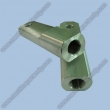Surface roughness of mechanical parts are three kinds of selection methods, namely, calculation, test method and analogy. In mechanical part design work, is the most common analogy, this method is simple, rapid and effective. Application of analogy the need for adequate reference manuals available in a variety of mechanical design provide a more comprehensive information and documentation. The most commonly used is compatible with the tolerance level of the surface roughness. In general, the smaller the dimension tolerance of mechanical parts, mechanical parts of the surface roughness is also smaller, but they are not there a fixed function. For example, some machines, the instrument handle, hand wheel and sanitation equipment, food machinery on the surface modification of some mechanical parts, they are very smooth surface of the processing requirements of demanding that the surface roughness, but the dimension tolerance of very low. In general, there are dimension tolerance of the parts, the tolerance level and surface roughness or a certain correspondence between the relations.
Design of mechanical parts in a number of manuals and monographs in mechanical manufacturing, the surface roughness of machined parts and mechanical parts of the dimensional tolerances between the formula have a lot of experience and presentation, and the list for readers to choose from, but as long as access to care will found that while the experience of taking exactly the same formula, but the list of values are not the same, and some have significant differences. This is not familiar with this area to bring a confusing situation. Also increased their choice in the mechanical parts work, the surface roughness of the difficulties.
In practice, for different types of machines, their parts in the same dimensional tolerances of the conditions, the surface roughness of the request is different. This is with the stability of the problem. In the mechanical parts of the design and manufacturing process, for different types of machines, its parts with the stability and interchangeability requirements are different. In the existing mechanical part design manual, reflected mainly in the following 3 types:
Category 1 is mainly used for precision machinery, the stability of the complexes demanding, requiring parts or in the course of several assembled, its parts wear limit part size tolerance value of not more than 10%, mainly used in precision instruments, meters, precision measuring tools on the surface, a very important part of the friction surface, such as the inner surface of the cylinder, precision machine tool spindle neck, coordinate boring machine spindle neck.
Type 2 is mainly used for ordinary precision machinery, the stability of the complexes are higher, and required part of the wear limit part size tolerance value of not more than 25%, requires a good seal contact surface, and its main applications such as machine tools, tools, and rolling with the surface of the taper pin holes, as well as relatively high velocity, such as sliding bearing contact surfaces with the surface of the face gear teeth and so on.
Category 3 is mainly used for general machinery, wear and tear of mechanical parts required limit does not exceed 50% of the value of dimensional tolerances, there is no relative motion of the part contact surface, such as cover, sleeve, requiring close to the surface, the work of key and keyway surface; relative speed is not high, the contact surface, such as the bracket holes, bushings, axle hole with a work surface, gear and more.
Here we have all kinds of mechanical design manual table values for statistical analysis, the surface roughness of the old national standard (GB1031-68) into the light of international standards ISO 1983, issued by the new national standard (GB1031-83 ), using the preferred evaluation parameters, namely, the arithmetic mean deviation of profile Ra = (1) / (l) ∫ l0 | y | dx. Ra by using the first series of preferred values derived surface roughness Ra and the dimensional tolerance on relationship between IT as a
Category 1: Ra ≥ 1.6Ra ≤ 0.008 × IT
Ra ≤ 0.8Ra ≤ 0.010 × IT
Category 2: Ra ≥ 1.6Ra ≤ 0.021 × IT
Ra ≤ 0.8Ra ≤ 0.018 × IT
Category 3: Ra ≤ 0.042 × IT
Relationship will be a list of the above 3, as shown in Table 1, Table 2, Table 3.
Work in mechanical part design, surface roughness by size tolerance value, the choice should be based on different types of machines, select the appropriate table values.
It should be noted that table 1 series with the value of Ra, and Ra, the old national standard limit values for the first 2 series, the conversion may encounter numerical problems by relying on and the next. We use the value in the table by table, as this will help improve product quality, individual values by using the next. Old national standard tolerance grades and surface roughness of the table of content and form are more complex, the same size on the same section the same tolerance level of basic dimensions, hole and the shaft surface roughness values are not the same, different types of values is not the same with This is due to the tolerance and fit the old standard (GB159-59) values and the tolerance factors. The current tolerance and fit the new national standard (GB1800-79) on the same level of tolerance within the same size and basic dimensions sub-standard tolerance values are the same, so the tolerance level for the corresponding table with the surface roughness greatly simplified, and more is reasonable.
In the design work, the choice of surface roughness final analysis must proceed from reality, a comprehensive measure of parts of the surface features and technology economy in order to make a reasonable choice. Tolerance level given in the table and surface roughness values for design reference.







